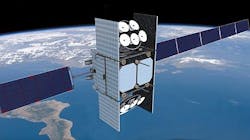Boeing to produce more wideband global SATCOM satellites for US Air Force
Jan. 18, 2012
EL SEGUNDO, Calif., Jan. 18, 2012. Boeing [NYSE: BA] has received authorization from the U.S. Air Force to produce and launch the eighth and ninth Wideband Global SATCOM (WGS) satellites. The WGS-9 authorization and the WGS-8 production option, which was authorized last month, have a combined value of $673 million and are part of the $1.09 billion contract modification announced by the Air Force in September 2011. WGS-8 and -9 will join four other satellites that are part of the Block II series. Block II adds a switchable radio frequency bypass that enables the transmission of airborne intelligence, surveillance and reconnaissance imagery at data rates approximately three times greater than the rates available on Block I satellites. WGS-9 is being funded through a cooperative agreement that the U.S. Air Force has forged with Canada, Denmark, the Netherlands, Luxembourg and New Zealand. This expands the WGS international partnership beyond WGS-6, which was funded by the Australian government in 2008. WGS satellites are built on the proven Boeing 702HP platform, which features xenon-ion propulsion, deployable thermal radiators, and triple-junction gallium-arsenide solar arrays that enable high-capacity, flexible payloads. The WGS communications payload has unique flexibility that is important to the military, as well as the ability to interconnect terminals that operate in different frequency bands and to reposition coverage beams based on evolving mission needs. WGS supports missions including tactical communications to and between ground forces, and relaying data and imagery from airborne intelligence, surveillance and reconnaissance platforms.
Voice your opinion!
Voice your opinion!

